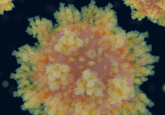Frog skin fights the flu

The Southern Indian Frog may help combat the influenza virus.

The Hydrophylax bahuvistara frog found widespread in India secretes host-defence peptides
The Influenza virus causes one of the most common recurring human respiratory illness, affecting 3-5 million people and causing roughly 375,000 deaths every year. There is no pill or liquid that can cure the flu, so most individuals manage their symptoms with home remedies.
Anti-viral medications and flu vaccines are currently available, offering quicker symptom relief and protection, respectively. However, the continuous emergence of drug resistant viral strains raises a mounting concern and urgent need to develop effective flu-specific antiviral treatments. Now researchers writing in the journal Immunity report a surprising new ally in the battle against drug-resistant flu viruses: A colourful little frog painted with orange and brown, the Southern Indian frog.
In 1987, Michael Zasloff and Dudley Williams demonstrated that amphibians secrete large quantities of peptides from their skin as a critical innate defence mechanism against microbial infections. Further research on these peptides indicated that they also possessed activity against some human viruses. For the new study, David Holthausen from Emory University in Atlanta and his team set out to determine whether the frog secretions might combat the Human Influenza A virus.
Holthausen travelled to Kerala, India and searched for adult Southern Indian frogs (H. bavuvistara). He then harvested their skin secretions, which contain host-defence peptides called urumin. Back in the lab, he isolated the urumin RNA, performed PCR and cloned the products Urumin. The researchers next incubated recombinant Urumin with certain strains of the influenza A virus that circulated within the human population from 1934 to 2013 and measured the extent of antiviral activity using a plaque assay.
Electron Microscopy revealed that Urumin physically destroyed eight of the twelve strains of the influenza virus. This unique peptide specifically targets conserved regions of hemagglutinin-bearing human influenza A virus, causing viral disruption.
Based on their observations, Holthausen and his team propose that when urumin binds the conserved stalk region, it initiates conformational changes in hemagglutinin, resulting in electrostatic forces that lead to destruction of the virus. Urumin’s mechanism of action does not fit into any previously defined category for antiviral activity against influenza, making it a completely distinctive new compound for drug development.
To find out if urumin could fight the flu in animals, the researchers administered small amounts of the peptide to mice with influenza and revealed that it protected them from infection.
By taking advantage of pre-existing innate host defence mechanisms, Holthausen and his team offer a promising new candidate for drug-resistant influenza viral strains and a potential solution for creating new flu-fighting treatments. Development of this anti-viral peptide remains in its infancy; the team plans next to elucidate Urumin’s specific binding site, it’s mechanisms of virucidal acitivity, and strategies to deliver Urumin as a drug.





